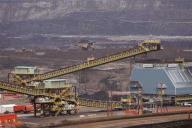Oil sands solidarity cracks under pressure
 Calgary - Ottawa, Canada — Faced with rising pressure from environmental groups and big institutional investors, a group of small oil sands companies have broken industry ranks to characterize themselves as the green vanguard of Fort McMurray.
Calgary - Ottawa, Canada — Faced with rising pressure from environmental groups and big institutional investors, a group of small oil sands companies have broken industry ranks to characterize themselves as the green vanguard of Fort McMurray.The companies have joined a growing, but disparate effort by the oil industry – along with the federal and Alberta governments – to counter an aggressive lobbying campaign that has arisen around U.S. President Barack Obama’s visit to Canada. Environmental groups are looking to persuade the new U.S. administration to introduce new regulations that would cripple oil sands producers.
As those critics continued their attacks yesterday, oil companies also faced growing pressure from major U.S. investors over financial and environmental risks posed by their oil sands projects.
In a news conference yesterday, executives from the Ceres investor group – a coalition of pension funds and non-governmental organizations – placed two companies, Chevron Corp. and Canadian Natural Resources Ltd., on a “climate watch list” for their alleged failure to address their environmental problems in the oil sands.
But the newly formed In Situ Oil Sands Alliance argues that not all companies should be tarred with the same brush as major oil sands miners such as Chevron, Syncrude Canada Ltd. and Suncor Energy Inc., whose projects scour vast tracts of boreal forest and require immense tailings ponds.
In contrast, the in situ method – called steam-assisted gravity drainage or SAGD – has a far smaller landscape footprint because it does not create tailings ponds, uses one-fifth the water of mining projects, and uses primarily brackish water instead of fresh, the alliance members argue.
“I think it’s totally unfair that SAGD is seen as dirty oil,” said Sveinung Svarte, president of Athabasca Oil Sands Corp., one of the alliance’s founding members.
“We are all considered environmentally unfriendly, but with footprint and water we are not in the same league at all. And we wanted to be seen as different. And if the Americans really sat down and looked at all the different environmental parts of it, they would see that the California oil is as polluting as bitumen from SAGD.”
However, the SAGD method is a more energy-intensive extraction process, and typically emits 20-per-cent more greenhouse gases per barrel of bitumen than does the mining method.
The alliance members include a group of smaller companies that are designing new technologies that will reduce in situ’s natural gas requirements and, they say, put it on an environmental par with U.S. crude imports from Mexico and Venezuela. The members include Laricina Energy Ltd., MEG Energy Corp., Osum Oil Sands Corp. and Petrobank Energy and Resources Ltd. The Ceres investors group did not distinguish between mining and in situ projects yesterday when it added the two oil sands companies to its watch list. It argues that both methods produce unacceptable levels of greenhouse gases.
“Extracting oil from tar sands is a dead end on the road to a clean energy future, and a risky venture for investors,” Ceres president Mindy Lubber said in a conference call.
“Investors have a message for President Obama on the eve of his visit to Canada: Please do not forsake long-term prosperity and long-term shareholder value for short-term energy independence.”
In an interview with CBC this week, Mr. Obama acknowledged the need to improve the environmental performance of the oil sands, comparing the issue the United States’ need to dramatically cut emissions from its coal-fired utilities, which supply half that country’s electricity.
But he said the answer lays in technology such as carbon capture and storage – a hugely expensive method of diverting carbon dioxide from power plants and other large projects and injecting it for storage underground.
To see how Klean Industries is developing environmentally friendly, cost effective energy solutions for the oil sands in Alberta, please click here.
You can return to the main Market News page, or press the Back button on your browser.

